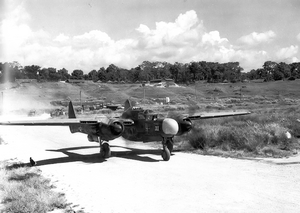419th Night Fighter Squadron
| 419th Night Fighter Squadron | |
|---|---|

419th NFS 42-5506 taxiing at Carney Airfield, Guadalcanal, Solomon Islands, shortly after the P-61's arrival in early 1944
|
|
| Active | 1943-1947 |
| Country |
|
| Branch |
|
| Type | Squadron |
| Role | Night Fighter Operations |
| Part of | Thirteenth Air Force |
| Engagements | |
| Insignia | |
| Emblem of the 419th Night Fighter Squadron |  |
The 419th Night Fighter Squadron is an inactive United States Air Force unit. Its last assignment was with Thirteenth Air Force, being inactivated at Floridablanca, Luzon on 20 February 1947.
The unit was formed in 1943. After training, it was deployed to Thirteenth Air Force and ordered to New Guinea to provide air defense interceptor protection against Japanese night air raids on USAAF airfields. It later served in the Philippines Campaign where in addition to night interceptor missions it also flew day and night interdiction missions against enemy troop movements, brides and other targets of opportunity. It was inactivated in 1947.
Activated on 1 April 1943. Trained at Kissimmee, Florida and trained in Douglas P-70 Havoc night fighters due to non-availability of P-61 Black Widows. By the end of training, the night fighter pilots realized that the Black Widow would not be forthcoming and resigned themselves to the fact they would be going overseas with P-70s.
The squadron was deployed to the South Pacific Theater, arriving at Guadalcanal, Solomon Islands on 15 November 1943, assigned to Thirteenth Air Force. It was the second dedicated night fighter squadron assigned to the Pacific. At Guadalcanal, the squadron absorbed Detachment B of the 6th Night Fighter Squadron. On 21 November 1943, the squadron was assigned to the 18th Fighter Group.
However, it was found that the P-70 was not very successful in actual combat interception of Japanese fighters at night. It was issued P-38H Lightnings stock day fighters with no radar or any other equipment for finding the enemy at night. The Lightning pilots would wait until the enemy was over a target and, hopefully, illuminated by the defender's searchlights. They would then try to pick out the outline of the enemy aircraft and intercept. This method had its dangers since the P-38 was subjecting itself to antiaircraft fire from defenders as well as gunners aboard the Japanese bombers. The squadron received the P-61 Black Widow to replace the P-38s/P-70s in May 1944. Then on 25 August 1944, the squadron was reassigned to the XIII Fighter Command.
...
Wikipedia
